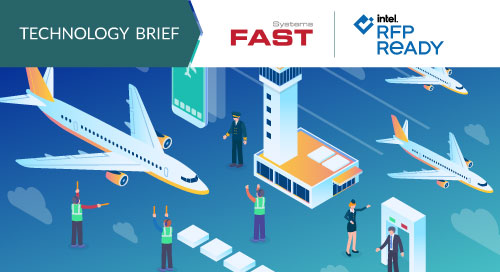Fill form to unlock content
Error - something went wrong!
Your content is just a step away. Please submit below.
Thank you!
The Future of Access Control with IoT Security

Protection from internal and external security threats can feel like a never-ending challenge. The complexities of deploying safety measures to prevent unauthorized access across dynamic environments with a diversity of platforms can be costly and labor-intensive.
As a result, organizations look to install stronger access control that can seamlessly integrate with existing systems and processes, and support greater operational efficiency. And deploying IoT security solutions make it possible.
One example is Vienna International Airport—the biggest aviation hub for travel between Central and Eastern Europe—serving up to 31 million passengers annually. Like most airports, Vienna International goes through continual expansion, construction, and maintenance. And with approximately 80,000 employees, subcontractors, and annual visitors, secure and centralized access control becomes essential.
The airport needed to upgrade its outdated system over a one-year transition period—without disrupting operations and workflows—not an easy undertaking. To address these challenges, the airport operations team turned to FAST Systems, a pioneer in the field of digital safety and security technologies.
“The task was to provide a solution that could manage the access control for 30,000 active identities, including internal airport employees and external personnel doing construction work or services,” says Carsten Tschritter, CTO at FAST Systems. “Our automation methodology involved aligning with processes and workflows, and facilitating the automation of most access security elements without interrupting airport operations.”
To accomplish this, the company deployed its Flow4Secure Process Automation and Workflow Management platform. This provided a customized and fully integrated Identity and Access Management Solution (IDMS) that complies with EU General Data Protection Regulation (GDPR) and Aviation Security Regulations.
AI-Powered Access Control
The AI-powered platform Flow4Secure was developed after FAST Systems saw organizations struggling with a range of security issues. Most prominently: bringing multiple access control operating systems and sensitive personal data together.
Managing identities for an airport requires insights into tens of thousands of personal data records and control of thousands of doors across the facilities. This challenge can overwhelm users and make it extremely difficult to maintain regulatory compliance and internal Standard Operation Procedures (SOPs).
The ability to manage three different Access Control Systems (ACS) through one middleware application enables security operators to use workflow-driven applications to process ID cards and vehicle badges with automated assignment to external companies and internal departments. The solution automatically allocates access areas during the application process and activates access rights when issuing ID cards in all connected ACS.
“It was clear we wanted to have a vendor-agnostic integration platform that connects all the unconnected systems,” Tschritter explains. “By merging all Access Control Systems into one platform, Vienna airport is able to use and analyze personal information to provide better security by applying efficient and well-defined workflows.”
Flow4Secure makes it easy to see all the relevant information about identities and ACS #data points in one place to quickly detect and address any issues. FAST Systems AG via @insightdottech
The core idea behind the solution is to simplify operations for the end user, external subcontractors, and visitors by offering intuitively usable web portals, the control elements, which are adapted to the tasks of the respective user groups. With its simplified user interface, Flow4Secure makes it easy to see all the relevant information about identities and ACS data points in one place to quickly detect and address any issues.
The Flow4Secure system collects, combines, and correlates data from various disparate systems and devices such as card readers, printers, scanners, cameras, and more. The open and scalable system architecture allows continuous development of new applications supporting Vienna airport’s desire to aggregate and digitize all operations going forward.
“It’s a tough job to manage companies, organization structures, orders, personal data, and vehicles in a hierarchy, which requires defining the allocation of access rights,” says Tschritter. “Our task was to provide a user-friendly and process-driven interface that included all necessary information to ID office staff for 100% controlled operations.”
In the case of the airport, the Flow4Secure solution provides a high-availability platform with staging for production, testing, training, and integration purposes. The integration of Access Control and all relevant systems can run in a test environment before uploading it to productive systems.
The Power of Partnerships Uplevels Security Standards
All of this is made possible through the company’s powerful partnerships with Intel® and Dell. “The relationship with Dell started when Intel was conducting a trial with a railway station in Berlin,” says Bernd Drescher, Vice President of Sales at FAST Systems.“The Dell team was quite enthusiastic to see how we were able to address this customer’s unique requirements. Now we are in the final process of setting up new Dell appliances that integrate the Flow4Secure for process-driven solutions like Yard Management, Asset Tracking, and Visitor Management.”
On the technical side, of course, it’s essential to have a reliable hardware platform. “For us, it comes from this constellation of working together with Dell on the graphic side, our 3D GIS map system,” adds Carsten. “And on the CPU side, it’s Intel, where we have access to R&D and software performance testing resources as needed.”
The Future of Access Security
Having integrated security systems like Flow4Secure—built on Dell, powered by Intel—will become more important as IoT adoption continues, Drescher explains: “The needs for integration platforms are growing at the same pace as the number of connected devices.”
Organizations need to move toward access control system integration and cross-platform interoperability if they want to be able to monitor and improve their operations easily and effectively.
Tschritter predicts that with the rise of 5G, higher bandwidth, and the edge, this will become only a bigger advantage in the future.
This article was edited by Leila Escandar, Editorial Strategist for insight.tech.
This article was originally published on June 2, 2022.